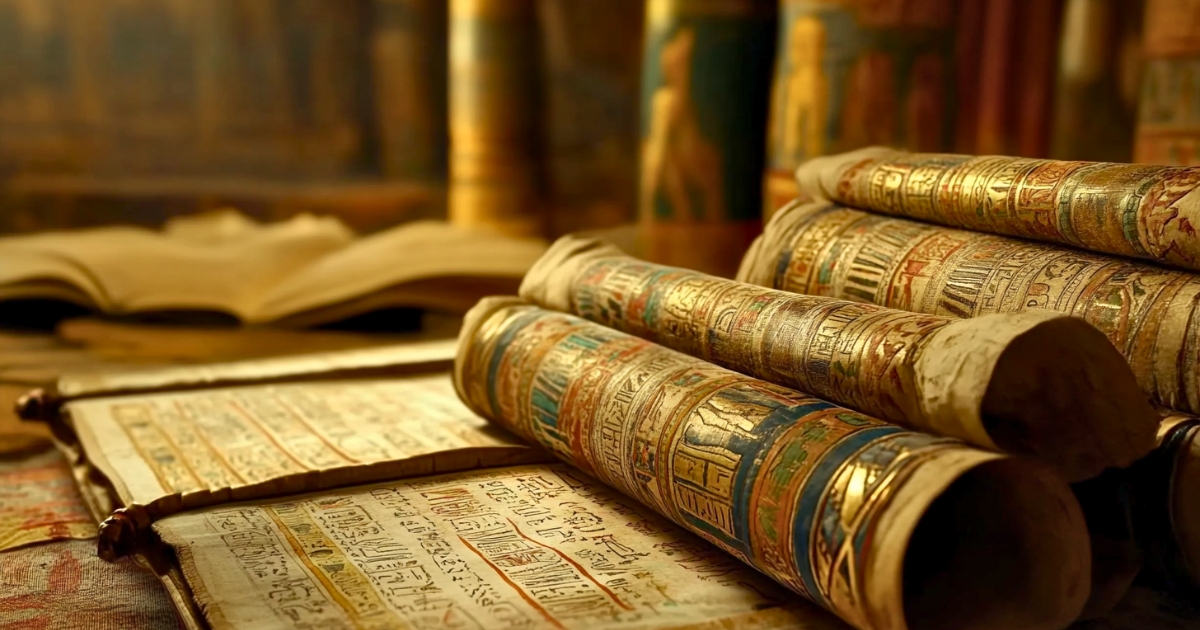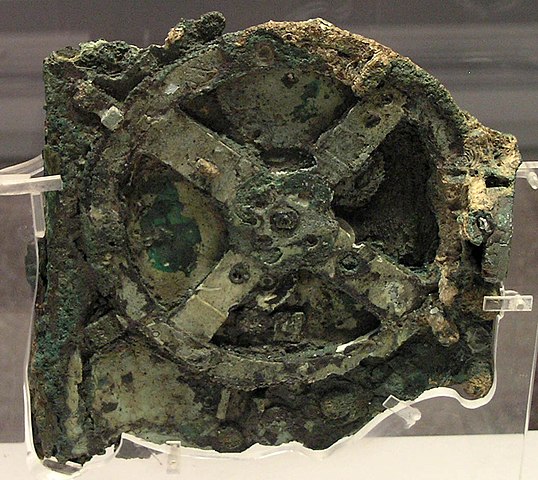Cleopatra, known as the last queen of ancient Egypt, has her name etched in history alongside her beauty, power, and tragic end. During her reign in the 1st century BCE, the Library of Alexandria, renowned as the largest library in the ancient world, also existed. While many mysteries surround Cleopatra’s relationship with the library, this article will explore the history of the Library of Alexandria and the treasure trove of ancient knowledge it housed, set against the backdrop of Cleopatra’s era.
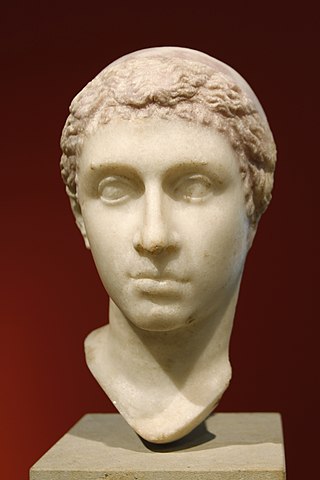
Bust of Cleopatra VII in the Altes Museum, Berlin © José Luiz Bernardes Ribeiro
- History of the Library of Alexandria
- The Library’s Collection
- Library Management
- Activities of Scholars of the Time
- Cleopatra and the Library
- Decline of the Library
- The Library and Ancient Egyptian Culture
- Lost Ancient Knowledge
- Impact on the Modern World
- The New Library of Alexandria: Revival of the Ancient Spirit
- Conclusion
History of the Library of Alexandria
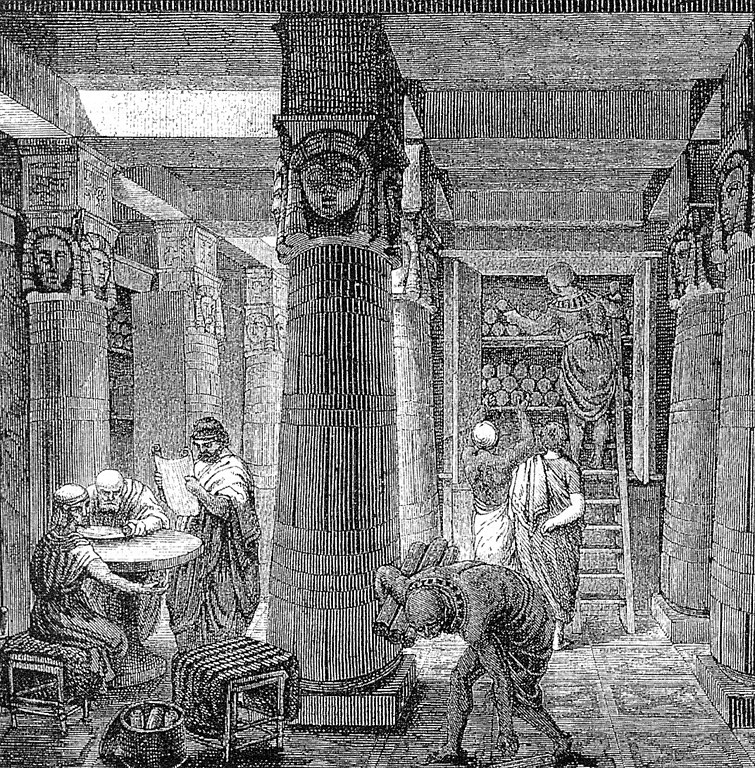
Reconstruction of the Library of Alexandria based on some archaeological evidence
The Library of Alexandria was founded in the early 3rd century BCE by Ptolemy I Soter. Built in Alexandria, Egypt, this library was known as the largest in the ancient world and served as a center of scholarship.
Successive rulers of the Ptolemaic dynasty contributed to the library’s development. For instance, Ptolemy II Philadelphus focused on expanding the library and enriching its collection, gathering books from around the world. Ptolemy III Euergetes borrowed original tragic works from Athens and had them copied.
By the time of Cleopatra’s reign in the 1st century BCE, the library had already amassed a vast collection of books from around the world over its 300-year history.
The Library’s Collection
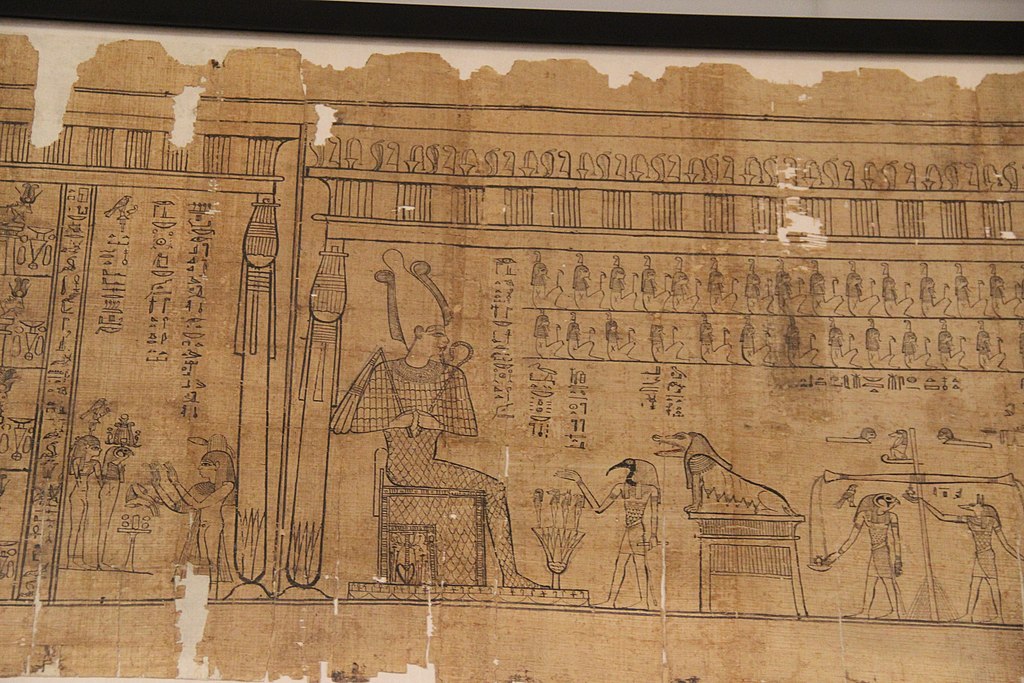
An ancient Egyptian Book of the Dead papyrus. Gary Todd from Xinzheng, China, CC0, via Wikimedia Commons
The exact number of books in the Library of Alexandria is unknown, but ancient records suggest it held between 400,000 and 700,000 volumes. These works were stored in the form of papyrus scrolls.
The collection was diverse, covering philosophy, mathematics, astronomy, physics, natural sciences, literature, and all known fields of knowledge at the time. While Greek texts dominated, the library also collected works in Egyptian, Hebrew, Persian, and other languages.
Notably, the library had a policy of collecting books from around the world. All ships entering Alexandria were required to submit their books for inspection, and the library staff had the right to copy them. This aggressive collection policy established the library as a “universal library,” gathering knowledge from across the globe in one place.
Library Management
The Library of Alexandria was more than just a repository for books. It also functioned as a research institution. The library was part of a research center called the Mouseion (Temple of the Muses), where many scholars conducted their studies.
The library was managed by a “Chief Librarian.” While the identity of the Chief Librarian during Cleopatra’s time is unknown, renowned scholars like Eratosthenes and Aristarchus had held this position in the past.
The library staff included scribes, copyists, and proofreaders. They were engaged daily in copying new books, preserving existing texts, and creating catalogs. The library also attracted scholars from around the world who could freely conduct their research there.
Activities of Scholars of the Time
The Library of Alexandria attracted the greatest minds of the ancient world. Mathematicians like Euclid, physicists like Archimedes, and astronomers like Ptolemy all conducted research here.

Archimedes’ principle: In the left diagram, an object is suspended in water, showing a weight of 4N. In the right diagram, the object is fully submerged in water, and the weight of the displaced water (3N) equals the buoyant force acting on the object. As a result, after the object is submerged, the scale shows 3N, which is the weight of the displaced water. The object itself now weighs 1N (4N – 3N), demonstrating that it has become lighter due to buoyancy. Archimedes is believed to have studied in Alexandria. MikeRun, CC BY-SA 4.0, via Wikimedia Commons
Their research was wide-ranging. For example, Eratosthenes calculated the Earth’s circumference with remarkable accuracy. Aristarchus proposed the heliocentric theory, pioneering the concept of a sun-centered solar system. Heron invented the prototype of the steam engine, laying the foundation for the Industrial Revolution over 2000 years later.
These scholars utilized the library’s vast resources to advance their research, engaging in discussions and generating new knowledge. The Library of Alexandria was indeed the “Silicon Valley” of the ancient world.
Cleopatra and the Library
Cleopatra was more than just a politician. She was highly intelligent and had a deep love for learning. According to Plutarch, Cleopatra spoke nine languages and was well-versed in mathematics, astronomy, and philosophy.
It’s believed that Cleopatra, like other scholars, used the Library of Alexandria. While there’s no direct evidence, there are indirect indications and scholarly speculations:
- Cleopatra’s educational background: As a member of the Ptolemaic royal family, Cleopatra received the highest level of education. The Library of Alexandria was the premier center of learning at the time, and it’s highly likely she studied there.
- Basis for political decisions: Cleopatra’s political judgments required extensive knowledge. The library’s vast collection likely served as an important source of information for her policy-making and diplomatic strategies.
- Interest in science: There are records of Cleopatra writing treatises on cosmetics and medicines. These studies may have referenced medical and scientific texts from the library.
- Cultural policy: Cleopatra sought to position Alexandria as a center of learning to demonstrate Egypt’s cultural superiority. The library likely played a crucial role in advancing this policy.
Decline of the Library
By Cleopatra’s time, the Library of Alexandria was already showing signs of decline. The main factors were:
- Political instability: The political turmoil in the late Ptolemaic period led to decreased support for the library.
- Increasing Roman influence: As Roman influence grew, Egypt’s academic independence was threatened.
- Internal conflicts: Disputes among scholars and between different schools of thought negatively impacted the library’s operations.
- Lack of funding: Political turmoil and wars led to a shortage of funds necessary for maintaining the library.
The library reportedly suffered significant damage during the civil war with Rome in 48 BCE. While Cleopatra attempted to restore the library, it never fully recovered.
The Library and Ancient Egyptian Culture
The Library of Alexandria played a crucial role in the development of ancient Egyptian culture and scholarship. It was a place where Greek and Egyptian cultures merged, and knowledge from various fields converged. The library’s existence positioned Alexandria as an international center of learning, contributing to Egypt’s cultural superiority.
Lost Ancient Knowledge
The loss of the Library of Alexandria resulted in the permanent loss of much valuable ancient knowledge. For example:
- Lost ancient literary works: Many ancient Greek tragedies and epics have not survived to the present day.
- Ancient scientific and technological knowledge: Designs for advanced machines like the Antikythera mechanism (an ancient Greek mechanical computer) and much of ancient medical knowledge have been lost.
The Antikythera mechanism: A sophisticated mechanical calculator from ancient Greece, believed to have been made around the 1st century BCE. It had advanced functions such as predicting celestial movements, demonstrating the high level of astronomical and mechanical engineering knowledge of the time. No machine-readable author provided. Marsyas assumed (based on copyright claims)., CC BY-SA 3.0, via Wikimedia Commons
- Lost historical records: Detailed historical records of ancient civilizations have been lost, creating significant gaps in our understanding of history.
- Ancient philosophy: Many philosophers’ works have not survived in their complete form, making it difficult to grasp the full picture of ancient thought.
Impact on the Modern World
The loss of the Library of Alexandria had a significant impact on the development of human knowledge. Much of the lost knowledge was only rediscovered in modern times after passing through the Middle Ages.
However, the spirit of the Library of Alexandria lives on in the modern world. For example:
- Modern library systems: The idea of gathering knowledge from around the world in one place is carried on in modern national libraries.
- Digital archives: Online encyclopedias and digital libraries can be seen as modern versions of the Library of Alexandria.
- International academic exchange: The practice of scholars from around the world gathering to share knowledge is reflected in modern international conferences.
- Universality of learning: The approach of accumulating knowledge from all fields and conducting comprehensive research is connected to modern interdisciplinary studies.
The New Library of Alexandria: Revival of the Ancient Spirit
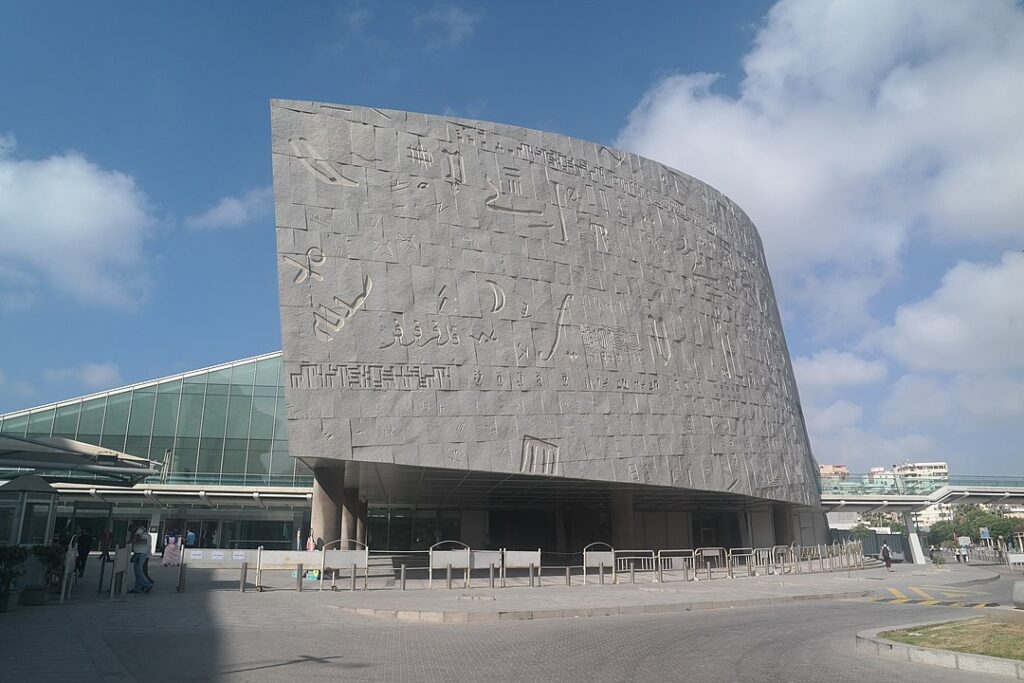
The exterior of the new Library of Alexandria (Bibliotheca Alexandrina), opened in 2002. Its innovative disc-shaped design evokes the ancient Egyptian sun god, symbolizing the fusion of ancient wisdom and modern technology. This magnificent seaside structure has attracted worldwide attention as a modern temple of knowledge, carrying on the legacy of the ancient library. By Shivani Singh04 – Own work, CC BY-SA 4.0, Link
The legacy of the ancient Library of Alexandria has been revived in a new form in the modern era. In 1974, Alexandria University proposed the idea of rebuilding the library, and with international support, the “New Library of Alexandria (Bibliotheca Alexandrina)” opened in 2002.
The new library was built near the site of the ancient library by the sea, and its grand architecture and state-of-the-art facilities have once again drawn global attention. The innovative disc-shaped design evokes the image of the sun disc, symbolizing the fusion of ancient Egyptian civilization and modern technology.
The New Library of Alexandria is not just a library but a multi-functional cultural complex with various facilities:
- Main Library: Houses about 8 million books and collects materials in multiple languages.
- Four Specialized Libraries: Arts and Multimedia, Children’s, Young People’s, and Braille and Audio libraries.
- Three Museums: Antiquities, Manuscripts, and History of Science museums.
- Planetarium: An astronomical education facility using the latest projection technology.
- CULTURAMA: A cultural exhibition facility using a giant interactive screen.
- Conference Center: A facility capable of hosting international conferences and symposiums.
The new library also adapts to the digital age with initiatives such as:
- Digital Archive: Digitizing valuable ancient documents and books.
- Internet Archive: Preserving and providing access to information on the web.
- Open Access: Promoting free access to academic information.
The New Library of Alexandria carries on the spirit of the ancient library, shouldering the mission of collecting, preserving, and disseminating knowledge. It stands as a new symbol of hope for humanity, which once lost its ancient treasure trove of knowledge. More than 2000 years after Cleopatra’s time, Alexandria is once again striving to play its role as a global center of knowledge.
Conclusion
The Library of Alexandria in Cleopatra’s time played a crucial role as a repository of ancient knowledge. Cleopatra herself is believed to have used this library and benefited from it.
The loss of the library was an immeasurable loss for humanity. However, its spirit lives on in the modern world. While we mourn the lost knowledge, we must also strive to apply the principle of “pursuit of knowledge” embodied by the Library of Alexandria in our contemporary context.
The story of Cleopatra and the Library of Alexandria teaches us the importance of knowledge and the necessity of preserving and transmitting it. Although the ancient treasure trove of knowledge has been lost, its legacy continues to live within us.
